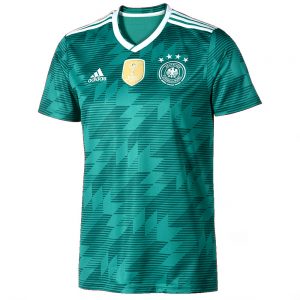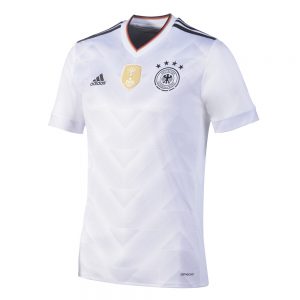Today, I ordered the latest addition to my ever-growing collection of Nationaltrikots. The new green retro-look Auswärtstrikot. I was always going to buy it as it is something I have done since I have been financially able to, but I was more enthused than usual by the modern yet “Italia 90” look of the new design. So enthused in fact, that I didn’t even bother too much about the price, which was a penny short of £60.
Football shirts are among the most popular garments out there. In any town or city, you will see at least one person wearing one, even when there is no actual football being played. Today, they are worn by both men and women. Little girls are just as likely to be seen in their favourite club or national shirt as little boys. But back in the day, when only men and boys were seen wearing them, these distinctive and occasionally loud polyester garments were the closest thing to what could be described as a male fashion item.
Things are different today, but back in the 1990s when my girlfriend was buying a new pair of shoes or a fancy skirt, I was buying… A football shirt.
An expanding collection
The new green Auswärtstrikot is my 41st German national shirt, the latest addition to a collection spanning over thirty years. Over this time, I must have spent thousands of pounds on this collection of shirts that now takes up one half of a bedroom wardrobe.

In Germany, the price of a new official Adidas Nationaltrikot is €89.95 – over 20% more than it was in 2006. Given the current Euro to Sterling exchange rate, that is quite a bit more than £60. For many who are not as obsessive, this is not an insignificant amount. Add the cost of a player name and number, and the total easily slips over the €100 mark.
The figures certainly do add up. If you are buying both the home and away shirts with names and numbers, you are shelling out well over €200.
If you are then buying replicas for a couple of kids, that amount can creep over €400. That’s right. Market forces are what they are, and those tiny Trikots for kids can cost you something over the other side of €50. This is not including the costs of replica shorts and socks. Not such a big deal for a grown-up, but a must-have for a little boy or girl who wants to play the part of Thomas Müller in the park on a Sunday afternoon.
Of course, every time a major tournament finals comes around, there is a new kit on the market. So as soon as you have bought the latest design, the clock is already ticking down on your having to buy another one. The situation for club shirts is even worse, as you can now find yourself buying three new designs every season.
Kerching, kerching.
A different ball game
Things were quite different not that long ago. It is hard to believe that the now iconic “flag” shirt, worn during Italia 1990, made its debut in the spring of 1988 and was sported by the Mannschaft until late 1991. That is four seasons, and two major international tournaments. Before then, there wasn’t even a consistent design.
Today, you can go to a local sports store and pick up a new Nationaltrikot. Or a shirt from any of the major international teams. Go online, and you can get hold of almost anything. Back in the early 1990s, it was a completely different ball game. If you were a British follower of the Mannschaft, you had to venture down to Soccer Scene, a rather niche store in London’s Carnaby Street. Here, you would find a haphazard range of international shirts, with prices that were – for a student as I was then – pretty eye-bleeding.
If you were lucky, you found something interesting. Only to discover that there was only one item, in a completely inappropriate size. This is why, back in the summer of 1990, the home “flag” shirt I ended up with was two, even three sizes too large for my (then) skinny 18 year old frame. Over time, I was able to grow into it. Well, sort of. I am a natural L who prefers a slightly roomier XL (i.e. more of a Müller than a Podolski). Even today, the XXL Trikot doesn’t exactly stick to the skin.
Had there only been a smaller size available that day, would I have bought it? Probably. If just to own it without being able to wear it.
An expanding market
By 1992, Adidas had done a lot of research. The famous trefoil logo was replaced by the current three bars, with the label “Adidas Equipment”. A market was tapped, and quickly expanded. Suddenly, Soccer Scene had plenty of the new shirts that were going to be worn at Euro 92. In a wide range of sizes. Both home and away colours. It was a smooth road from there on in.
By 1998, I no longer had to venture into the city hunting for Nationaltrikots. They were right there on my doorstep. A decade later, they were landing on my doorstep after a couple of quick clicks.
For many, the current price tag is a bit much. If just to rub it in, the white Heimtrikot that was introduced in late 2016 was itself replaced less than a year later. The life span of a German national shirt had never been so short. The argument was that this design was for the FIFA Confederations Cup in the summer of 2017, and was always going to be replaced the following year with a new model that would be worn at the FIFA World Cup the following year.

This all meant that fans and Nationaltrikot enthusiasts had shelled out two big amounts in the space of a year. For many, there was really no need to roll out a new design for the Confed Cup. Germany had played in this tournament twice before, and had never found the need to roll out a like-for-like replacement kit.
It was a real shame, as the Trikot worn at the Confed Cup was a fantastic design.
Where the money goes
So, why are the prices so steep? The usual target for most disgrunted fans is the manufacturer Adidas. They could not be more wrong.
Of the €89.95 a German fan pays for a new Nationaltrikot, only €21.85 goes to the manufacturer. That is less than a quarter. So where does the rest of the money go? Does the German Football Federation (DFB) take a big swig of the jug? Nope. They only take €5.50 per unit, just over six percent.
The actual breakdown is interesting. €8.60 goes towards transportation costs, which together with Adidas’ return and the DFB’s slice only comes to €35.95, less than half of the total retail cost. The remainder goes to the retailer (€39.64) and on VAT (€14.36). Of course, the retailer doesn’t take all of that big percentage. Like everybody else in the chain they have to cover store, advertising and staffing costs.
So the next time you are in Germany and you bag yourself a new Nationaltrikot at Karstadt, Galeria Kaufhof or even the official shop at the DFB Museum in Dortmund, don’t blame Adidas. They are making only a little bit more than the German government takes in VAT (Umsatzsteuer).
This also explains why, in the months before a new release, various retailers can sell off the shelf Trikots at less than half price. But where’s the fun in buying a new kit when you know it is already on its way out? It is one hell of a tricky Trikot situation.
Inevitable beer spills
There is no doubt that modern-day football shirts are expensive. Manufacturers will tell us that this is all to do with the technology, the advanced materials used, and its ability to “wick the sweat away from the body of the wearer”. Whatever the wick that means. The reality is that while this is great for players, fans do not really need all that.
Granted, a Trikot these days is considerably more comfortable from those I remember from the seventies. Itchy, shiny material that bobbled easily in the wash and went even shinier if somebody (usually one’s cluless mother) took an iron to it. But for the average football fan, there is no real need for all of this clima-stuff. Nobody is going to be running around for ninety minutes or more, and most we will be doing is jumping around a bit while trying to avoid the inevitable beer spills.
As things stand, I will continue to add to my collection. I already know that once the World Cup is all done and dusted, the current kits will hang around for most of 2019 until they are replaced by the new Euro 2020 model. The price is also likely to creep closer to €100, even without any custom additions.
Will the complaints get louder? Of course they will. Will we still buy them? I think you can answer that one yourselves.
(The figures and statistics quoted here are taken from this very interesting Orange / Handelsblatt article)
